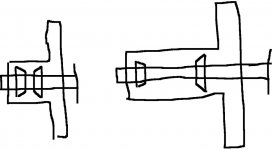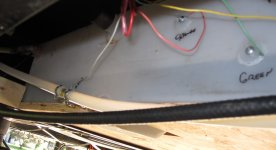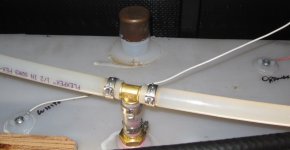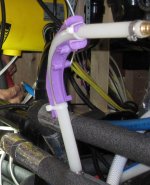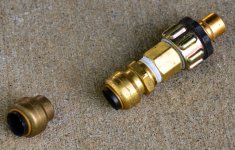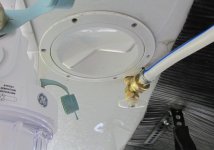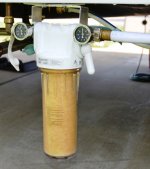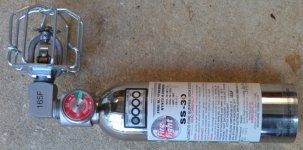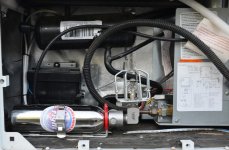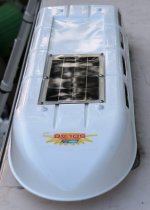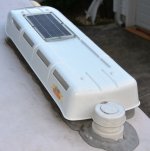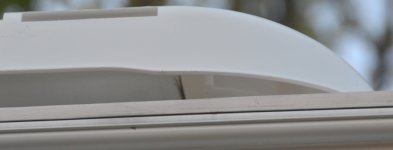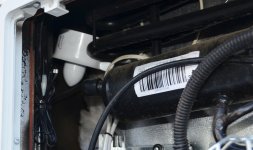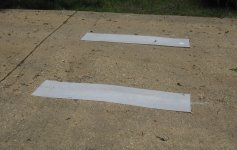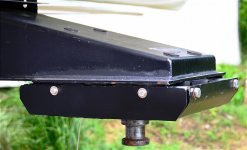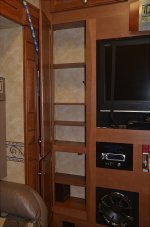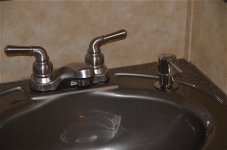You are using an out of date browser. It may not display this or other websites correctly.
You should upgrade or use an alternative browser.
You should upgrade or use an alternative browser.
And so it begins
- Thread starter porthole
- Start date
recumbent615
Founding MA Chapter Leader-retired
.
.
.
I have a flat wall mount heater in my motorcycle trailer. Does a fair job.
I'm waiting another month or so before pulling the cover off. Have no desire to work on it yet.
I do have a 2KW inverter to start thinking about installing. Maybe even permanently add my solar panel to the roof. Right now I have a 15 watt panel tied to the AC unit.
I leave the batteries in and this year I didn't not have to plug in the shore power.
Don't remember if you have a genny. But one of my projects is to also wire in a receptacle so that I can plug in circuits from the house for the next power failure.
After Irene passed through I was using my Honda 3000 for several days. Worked OK but the Cyclone has 25 gallons of gasoline. Just wish it was 240!
I do have a Genny - but my Rig and House are over 75 feet apart - so the best I can do is two 100 ft Cords into the kitchen - one for the Refer and the other for a few lights and to Charge phones and portable batteries for other items.
I'd love to get some Solar for the roof - but the cost is stopping me for now - I'll look at it again later this summer.
Kevin
truknutt
Committed Member
hubs never lube
Did your granddaughter get her hands on the markers?
porthole
Retired
Water tank replacement
I don't recall if I posted how I got the tanks. I made a case for unsanitary conditions by not being able to drain all the water from either tank and especially for having 15-20 gallons never draining from the front tank.
Heartland redesigned the tanks and sent me two tanks no charge if I was willing to do the work.
Water tanks. I lost some of my pictures of the tanks when I was installing them.
When I replaced the water tanks I increased the supports and changed most of the plumbing before the UDC.
The pictures below are the new style tanks with the small sump on the ODS. They hold almost no water now.
After these pics and a test fill I glued and screwed in blocks under the actual sump area.
These are slightly bigger then the stock tanks at 54 or 56 gallons.
The vent covered up with the copper pipe cap has since been uncapped and connected to the vent in the UDC.
All the OSB was discarded. In it's place is exterior grade 3/4" plywood soaked in West System marine epoxy. The first 6" on the left side by the sump cutout is doubled up with a second piece of epoxied plywood to strengthen that area.
The center supports were also replaced with some 3" wide stainless scraps I had.
The tanks were also angled up slightly on the right side to facilitate complete draining.
I don't recall if I posted how I got the tanks. I made a case for unsanitary conditions by not being able to drain all the water from either tank and especially for having 15-20 gallons never draining from the front tank.
Heartland redesigned the tanks and sent me two tanks no charge if I was willing to do the work.
Water tanks. I lost some of my pictures of the tanks when I was installing them.
When I replaced the water tanks I increased the supports and changed most of the plumbing before the UDC.
The pictures below are the new style tanks with the small sump on the ODS. They hold almost no water now.
After these pics and a test fill I glued and screwed in blocks under the actual sump area.
These are slightly bigger then the stock tanks at 54 or 56 gallons.
The vent covered up with the copper pipe cap has since been uncapped and connected to the vent in the UDC.
All the OSB was discarded. In it's place is exterior grade 3/4" plywood soaked in West System marine epoxy. The first 6" on the left side by the sump cutout is doubled up with a second piece of epoxied plywood to strengthen that area.
The center supports were also replaced with some 3" wide stainless scraps I had.
The tanks were also angled up slightly on the right side to facilitate complete draining.
Attachments
Last edited:
porthole
Retired
The plumbing was rearranged to allow all the water to run through a manifold in the UDC.
"Water in" from tank - city - or a sump hose (winterizing hose). The winterizing hose was lengthened to allow use with my portable water tank.
"Water out" to house systems, fresh water tank fill, black tank flush and hose bib under trailer.
Besides the valve for the black water flush, there is a check valve behind the UDC.
The items in the center picture:
A cap the snaps on the main line in (1/2" copper pipe) and a garden hose adapter the snaps on. Not seen is an adapter that snaps on from my water filter.
"Water in" from tank - city - or a sump hose (winterizing hose). The winterizing hose was lengthened to allow use with my portable water tank.
"Water out" to house systems, fresh water tank fill, black tank flush and hose bib under trailer.
Besides the valve for the black water flush, there is a check valve behind the UDC.
The items in the center picture:
A cap the snaps on the main line in (1/2" copper pipe) and a garden hose adapter the snaps on. Not seen is an adapter that snaps on from my water filter.
Attachments
Last edited:
porthole
Retired
Water filter snaps on to to machine screws with double nuts to form a "keyhole" attachment.
The 2 gauges are oil filled, stainless steel and made for motorcycles. Evilbay score and for under $20 each.
The Watts pressure regulator was a Lowe's score. Sitting on the discount rack for under $10.
Realized it was such a good deal and went back and bought the one left that was still on the shelf. 2 more "in and out " gauges for the regulator.
The 2 gauges are oil filled, stainless steel and made for motorcycles. Evilbay score and for under $20 each.
The Watts pressure regulator was a Lowe's score. Sitting on the discount rack for under $10.
Realized it was such a good deal and went back and bought the one left that was still on the shelf. 2 more "in and out " gauges for the regulator.
Attachments
porthole
Retired
Looking up at the roof line one day I noticed my fridge vent cover was broken - the day before the VA Beach trip, and in the front.
I removed it, rotated it 180 and did a duct tape repair. Good to go for the trip.
Ordered one of the Camco "universal" "fits everything" solar vent covers. well it fits, but not exactly.
Had to make up a block and add to the front of the vent riser. There is no room behind the vent due to a through roof vent pipe.
This cover has a solar panel on it that runs a small DC fan that you mount below the refrigerator coils on the back of the unit.
It is supposed to help keep your fridge working more efficiently. Couldn't tell you if it works or not.
The bullet looking thing is the fan
I removed it, rotated it 180 and did a duct tape repair. Good to go for the trip.
Ordered one of the Camco "universal" "fits everything" solar vent covers. well it fits, but not exactly.
Had to make up a block and add to the front of the vent riser. There is no room behind the vent due to a through roof vent pipe.
This cover has a solar panel on it that runs a small DC fan that you mount below the refrigerator coils on the back of the unit.
It is supposed to help keep your fridge working more efficiently. Couldn't tell you if it works or not.
The bullet looking thing is the fan
Attachments
porthole
Retired
My driveway is steep and the rear jacks drag, especially when the garage is loaded.
I was using a pair of built up 2x10's, about 8' long. Awkward and heavy.
These white strips are from the water tanks I changed out.
I back into the driveway until I hear the jack scrape, then dump the air for the hitch and air bags, slide these under the jacks and it slides right up the driveway like on ice.
I was using a pair of built up 2x10's, about 8' long. Awkward and heavy.
These white strips are from the water tanks I changed out.
I back into the driveway until I hear the jack scrape, then dump the air for the hitch and air bags, slide these under the jacks and it slides right up the driveway like on ice.
Attachments
Ray LeTourneau
Senior Member - Past Moderator
Duane, is the picture showing the fan, is the coiled up wire tied on the left side of the vent opening excess wire from the solar panel?? Just curious. I like the new reefer vent cover. Even looks a little more aerodynamic.The bullet looking thing is the fan
porthole
Retired
On our two week trip to Friendship, PA and Lake George I found I was always moving food stuff around. Just isn't enough storage in the little trailer.
So I gave up my coat closet and made a pantry. (top and bottom sections)
Plain old "Cherry" shelf boards from Home Depot and 1.5" angle brackets. Doesn't have to hold much weight.
So I gave up my coat closet and made a pantry. (top and bottom sections)
Plain old "Cherry" shelf boards from Home Depot and 1.5" angle brackets. Doesn't have to hold much weight.
Attachments
porthole
Retired
So, the bottle of Dawn in the galley and the Soft Soap in the head fell over and leaked just one too many times. Got out the big spade bit and added soap dispensers.
These tend to drip from the spout leaving some soap in the sides of the sinks. But, that is so much easier to clean up then the soap on the floor!
These tend to drip from the spout leaving some soap in the sides of the sinks. But, that is so much easier to clean up then the soap on the floor!
Attachments
Ray LeTourneau
Senior Member - Past Moderator
So, the bottle of Dawn in the galley and the Soft Soap in the head fell over and leaked just one too many times. Got out the big spade bit and added soap dispensers.
These tend to drip from the spout leaving some soap in the sides of the sinks. But, that is so much easier to clean up then the soap on the floor!
I did the kitchen dispenser quite a while ago. A problem I had may help you in the future. The dispenser had a steel ball in the pump actuator that eventually seemed to degrade and the pump lost it's ability to pull liquid from the bottle below it. After going through several replacement "ball bearings", I finally changed the dispenser to one that I found having a plastic mechanism for the "pump". No problem since. I guess the detergent has a little acidity to it that caused the metal ball bearing in the pump to degrade. Just a heads up if needed. I like the new pantry idea too!
Tool958
Well-known member
Hardwired Progressive EMS.
Mounted behind the basement wall on the door side. I needed 4' of 6 gauge 3 wire to make the connection post auto switch (for the genset/shore power)
This way protection is for either power source.
I got the version with the remote display and optional 2nd display.
The main display is in the basement next to the UDC. The second display is in the main cabin.
BTW - directions say you can't use telephone cable to extend or shorten the wire run. This is only partially correct.
The difference between th Progressive supplied wire and standard 4 conductor flat tele wire is the connectors are flipped relative to each other.
The monitors display in a scrolling fashion:
- Line 1 voltage
- Line 1 amp draw
- Line 2 voltage
- Line 2 amp draw
- Frequency
- any prior fault codes
- current system status
Duane. I just wanted to thank you for taking the time and effort involved to take pictures and document all of the mods you've done. I just finished with the Progressive install. It really was a fairly easy modification and the way I look at it, is it's cheap insurance. The only thing I did different was install 50 amp plugs on both sides of the EMS. That way if for some reason it would go bad, I can bypass it and still have power to the rig. You've given me several good ideas. The only problem is it's making more work for me to get done. Keep up the good work and really appreciate it.

